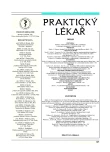A new tool in the prevention of thromboembolic complications in patients suffering atrial fibrillation - catheter-assisted occlusion of the left atrial auricle by the PLAATO system: Preliminary experience in the Czech Republic
Nová zbraň v prevenci tromboembolických komplikací nemocných s fibrilací síní – katetrizační uzávěr ouška levé síně systémem PLAATO: první zkušenosti v ČR
Embolická cévní mozková příhoda patří u nemocných s fibrilací síní mezi nejzávažnější komplikace. Mnoha studiemi je prokázáno, že dlouhodobá antikoagulační léčba výrazně snižuje riziko tromboembolických komplikací, ale díky složité monitoraci účinků léčby warfarinem není v současné době stále dostatečně využívána. Je známé, že většina trombů vzniká při fibrilaci síní v oušku levé síně. U nemocných se zvláště vysokým rizikem systémové tromboembolické komplikace můžeme v současné době použít novou, ale již ověřenou léčbu – katetrizační uzávěr ouška levé síně prováděný implantací balonkového okluderu. Zejména výhodná je tato metoda u nemocných s vysokým rizikem krvácivých komplikací spojených s dlouhodobou antikoagulační terapií, v případě neefektivní léčby s častým kolísáním hodnot protrombinového času nebo při nedostatečné spolupráci s nemocným. Naše první zkušenosti podporují zavedení této nové metody jako bezpečné a velmi účinné terapie nemocných s fibrilací síní, kdy jiné postupy ovlivňují vysoké riziko tromboembolie selhaly.
Klíčová slova:
cévní mozková příhoda – tromboembolie – fibrilace síní – katetrizační uzávěr ouška levé síně.
Authors:
P. Neužil 1; T. Mráz 1; P. Formánek 1; M. Táborský 1; P. Michálek 2; M. Švec 2; MUDr. Dana Vondráčková 3; Z. Beldová 1; D. Gross 1; J. Petrů 1; L. Šedivá 1; M. Kalina 3; P. Niederle
Authors‘ workplace:
Kardiologické oddělení Nemocnice Na Homolce, Praha
primář prof. MUDr. P. Niederle, DrSc.
1; Oddělení anestezie a resuscitace Nemocnice Na Homolce, Praha
primář MUDr. M. Ročeň
2; Neurologické oddělení Nemocnice Na Homolce, Praha
primář MUDr. M. Kalina
3
Published in:
Prakt. Lék. 2005; 85(6): 330-333
Category:
Of different specialties
Overview
Embolic cerebral stroke is among the most serious complications in patients suffering atrial fibrillation. In many studies it has been demonstrated that long-term anti-coagulation therapy has markedly lowered the risk of thromboembolic complications, however, due to the complicated monitoring of the effects of treatment with warfarin, it is not being applied sufficiently at present. It is a known fact that in fibrillation the majority of thrombi originate in the left atrial auricle of the heart. In patients especially prone to high risk of systemic thromboembolic complications there can now be applied a new and already verified approach – catheter-assisted occlusion of the left atrial auricle with a balloon occluder. It is advantagenous namely in patients having high risk of hemorrhage complications connected with long-term anti-coagulation therapy, in cases of ineffective therapy with frequent fluctuation of prothrombin time values, or in insufficient cooperation of the patient. Our preliminary experience supports the introduction of this new method as a safe and very effective treatment in patients suffering atrial fibrillation when other procedures affecting the high risk of thromboembolism had failed.
Key words:
cerebral hemorrhage – thromboembolism – atrial fibrillation – catheter-assisted occlusion of the left atrial auricle.
Labels
General practitioner for children and adolescents General practitioner for adultsArticle was published in
General Practitioner

2005 Issue 6
- Memantine Eases Daily Life for Patients and Caregivers
- Metamizole vs. Tramadol in Postoperative Analgesia
- Metamizole at a Glance and in Practice – Effective Non-Opioid Analgesic for All Ages
- Memantine in Dementia Therapy – Current Findings and Possible Future Applications
- What Effect Can Be Expected from Limosilactobacillus reuteri in Mucositis and Peri-Implantitis?
Most read in this issue
- The principle of dual effect and conscience
- Defecography in the diagnostics of anorectal dysfunctions
- Clinical significance of vitamin K for quality of bone and for calcified tissues
- Atypical course of type A thoracic aortal dissection in a pregnant woman
